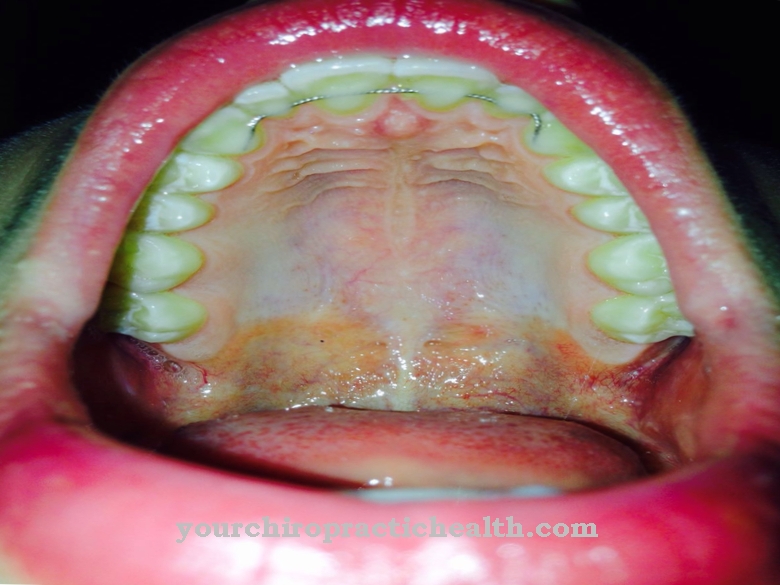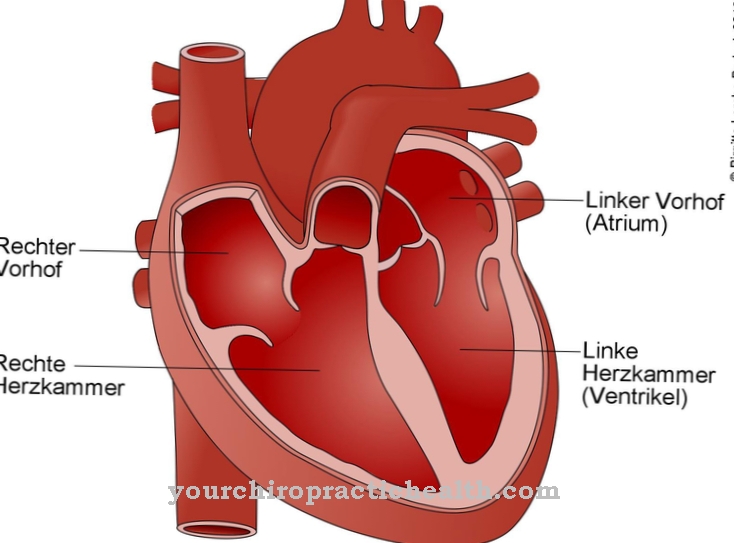Nerve roots are the connection between the peripheral and central nervous system. They lie in the vertebral canal of the spinal cord, where a spinal nerve carries an anterior and a posterior nerve root. The herniated disc is the most well-known disease that can cause a nerve root syndrome with symptoms such as sensory disturbances and paralysis.
What is the nerve root?
The central nervous system consists of the nerve tissue in the brain and the spinal nerves of the spinal cord. The extensions of the nerve cells are called axons. They receive, communicate with each other, receive stimuli from other nerve cells and transmit these stimuli from the cell body of the nerve cell, the so-called soma.
The nerve cells of the spinal cord also have nerve roots. These are nerve fibers that emerge in segments from the spinal cord or enter the spinal cord. The individual fibers of many nerve roots meet in the intervertebral canal in the form of a spinal nerve. Each spinal nerve has two roots: an anterior and a posterior nerve root. The anterior roots are efferents that transmit signals to the peripheral nervous system. The posterior roots are in turn afferents that transport signals from the central to the peripheral nervous system.
A nerve cell body is part of the anterior root of a nerve in the spinal cord and is also referred to as a root cell in this case. Charles Bell and François Magendie recognized the functional separation of the two nerve roots of each spinal nerve for the first time and documented it in the Bell-Magendie law. A certain nerve root area near the point of entry into the spinal cord is considered to be the transition zone between the peripheral and central nervous system and is known as the Redlich-Obersteiner zone.
Anatomy & structure
Nerve roots lie in the spinal canal. Every single segment of the spine has two nerve roots on the right and left side. These two roots fuse in the spinal canal to form the spinal nerve and leave the spinal canal through the intervertebral foramina, the so-called intervertebral vertebrae.
The human spine has anterior and posterior nerve roots per segment. The bevels of the posterior nerve roots arise from the posterior lateral sulcus between the lateral cord and the posterior cord. The fibers of the anterior nerve roots of the spinal nerves arise from the anterior lateral sulcus between the anterior and posterior cords of the spinal cord. Near the point of entry into the spinal cord, each nerve root has a so-called Redlich-Obersteiner zone.
This zone forms the border between the central nervous system and the peripheral nervous system and lies in the area in which the posterior root of a spinal nerve enters the posterior horn of the spinal cord. The afferent nerve fibers in this area have no medullary effects, but they have thinned medullary sheaths. The last Ranvier ring on each axon marks the transition. The posterior roots do not have a basement membrane at this point.
Function & tasks
The nerve roots of the spinal nerves connect the central nervous system with the peripheral nervous system. This connection is crucial for every body process. Without the nerve roots, commands from the brain would not reach the effectors in the body and could not be carried out by muscles, glands or organs. The body would not be viable with it. The central nervous system controls all conscious and unconscious body processes and only then gives the body its ability to survive.
The control of body processes by the central nervous system is not only dependent on stimulus-conducting nerves in the body periphery, but also depends on conducting nerve pathways from the peripheral nervous system. The former nerve tracts are called efferents. The latter are called afferents. The afferent nerve fibers enter the spinal cord and thus the central nervous system via the anterior nerve root and supply the central nervous system with sensitive information from the periphery, which is transported in the form of excitation. This sensitive information is, for example, notifications about the current state of tension in the muscles or the position of joints.
The central nervous system needs such information to issue commands insofar as it can only issue targeted movement commands to the muscles with this information. The nerve cell bodies of the afferent fibers are located in the spinal ganglion, where efferent nerve fibers also emerge from the spinal cord. Efferent fibers in the nerve roots carry motor commands to the muscles. The associated nerve cell bodies lie within the anterior horn of the spinal cord in the gray matter. The anterior nerve roots are the roots of the efferent fibers.
Diseases
The best known nerve root damage is the herniated disc. This is a sudden or slowly progressive displacement of the intervertebral disc tissue of the nucleus pulposus. Herniated discs can compress the spinal cord and pinch the nerve roots.
The clinical picture also refers to a degenerative spinal disease, as the cause is a degenerative change in the intervertebral disc or the adjacent structures. The annulus fibrosus tears and the gelatinous nucleus or nucleus pulposus falls forward. Herniated discs usually occur in a typical localization and then lie in the lower lumbar spine sections, where they cause nerve root syndromes. This symptom complex is caused by mechanical irritation of nerve roots of the spinal nerves.
In addition to the herniated disc, tumors, infections or fractures of the vertebrae can be involved in a nerve root syndrome. The most important symptom of the clinical picture is more or less severe pain, which can radiate from the lumbar spine into all parts of the body. Lumbago, for example, is also a nerve root syndrome. In addition to pain, loss of sensitivity and paresthesia can occur in the supply area of the affected nerve root, i.e. numbness and other abnormal sensations. These symptoms are due to damage to sensitive parts of the nerve roots.
Since each segment of the spine also has motor components in the anterior nerve roots, a nerve root syndrome can also be associated with paralysis. In this case, the movement disorders occur in the supply area of the efferent nerve root fibers.























.jpg)



